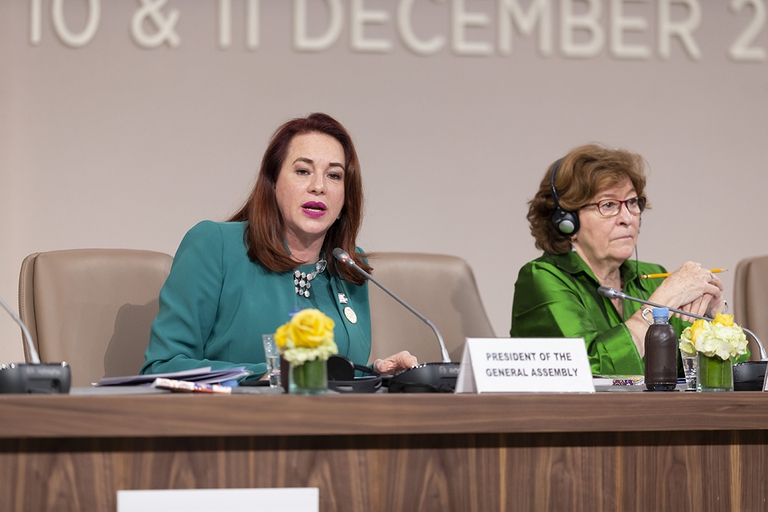
The Louise Michel is the humanitarian rescue ship saving lives in the Mediterranean. Financed by the artist Banksy, it has found a safe port in Sicily.
The Global Compact for Safe, Orderly and Regular Migration was signed by 164 nations in Marrakech. This is what the non-binding agreement that encourages international cooperation stipulates.
After a heated political debate that went on for months, the Global Compact for Migration was signed on the 10th and 11th of December by 164 countries (with the notable exception of Italy), in Marrakech, Morocco. But what does this UN document stipulate, specifically? And why has it been so controversial?
As is explained by the official website, the “Global Compact for Safe, Orderly and Regular Migration” is an agreement under the aegis of the United Nations. It’s the first ever agreement of its kind to have been negotiated between different governments with the goal of tackling on every dimension of international migration through an integrated approach. The phenomenon, after all, affects 258 million people: in other words, 3.4 per cent of the world’s population, for one reason or another, has abandoned its country of origin.
The history of the accord began on the 19th of September 2016, at the UN General Assembly, when the 193 representatives of the member states signed the New York Declaration on Refugees and Migrants. The declaration’s appendix provided a launchpad for further negotiations and consultations, whose end result was the Global Compact.
258 million migrants = 258 million stories, journeys & memories.
On Tuesday’s #MigrantsDay, let’s continue to advocate for migration #WithDignity in a safe & orderly manner: https://t.co/22xr77AONh pic.twitter.com/6h2MwALCIU— United Nations (@UN) December 18, 2018
The first thing that has to be clarified is that the Global Compact for Migration isn’t a binding piece of legislation and in no way impinges on state sovereignty; it simply establishes certain guidelines to follow for tighter cooperation in handling international migration. This is necessary because, as the document clearly states, “no state is able to face the challenges and opportunities of this global phenomenon by itself”.
Negotiators drew inspiration from well-established foundations: international law, the Universal Declaration of Human Rights (which just turned seventy), and many other UN Conventions, such as the Paris Agreement, the 17 Sustainable Development Goals, and the list goes on. Through a long and laborious path, all these documents were cross-referenced with research data, studies and expert contributions.
This long process of mediation resulted in 23 objectives, themselves declined into a series of actions.
Above is an extreme synthesis of the document which was approved in Marrakech last December. Notably missing from the list of 164 countries that signed the agreement were Donald Trump’s United States, as well as the bloc known as the Visegrád Group (Czechia, Hungary, Poland and Slovakia), joined by Austria, Bulgaria and Switzerland.
Even the Italian government led by Giuseppe Conte, chose not to take part in the Marrakech summit, and the decision on whether to sign the Compact was put to Parliament. The first debate, held on the 19th of December, failed to produce a decision. The motion that was approved, put forward by the majority, commits the government to evaluating the issue in greater depth before making a decision.
There are many myths & falsehoods about the Global Compact #ForMigration. Here are the facts ⬇️ pic.twitter.com/M6U69aXbah
— United Nations (@UN) December 14, 2018
The question was brought back for discussion on the 27th of February, with a motion for Italy to commit to “not signing the Global Compact” and “not contributing in any way to financing the Compact’s trust fund”. The motion was approved with only 112 votes, while the government’s majority abstained. After long discussions, then, Italy finally rejected the deal. With the same mechanism, the government also committed to “adopting initiatives to immediately create hotspots in North African countries to examine requests for asylum”.
Around mid-December 2018, with decidedly less widespread media coverage, the UN General Assembly approved, with a significant majority, another Global Compact: dedicated to the issue of refugees. These are often confused with migrants, but the term indicates a very different condition. A migrant is, in a general sense, anyone who leaves their country of origin; a refugee, on the other hand, is a person for whom returning to their country of origin would be too dangerous, a definition that established by the Geneva Convention in 1951.
Read more: From Bosnia to Trieste, migrants’ journey across the new Balkan route
This other compact was also drafted as a consequence of the New York Declaration in 2016, and it also not binding but focuses on improving international cooperation.
The @UN General Assembly has just agreed to a historic #RefugeeCompact. It is the biggest effort to broadly share refugee responsibilities that I have witnessed in 34 years of work with refugees. pic.twitter.com/CWiWUMvAuW
— Filippo Grandi (@RefugeesChief) December 17, 2018
It has four objectives:
In this case, only the US and Hungary voted against the measure, and even abstentions were few. Italy, for example, voted in favour.
Siamo anche su WhatsApp. Segui il canale ufficiale LifeGate per restare aggiornata, aggiornato sulle ultime notizie e sulle nostre attività.
![]()
Quest'opera è distribuita con Licenza Creative Commons Attribuzione - Non commerciale - Non opere derivate 4.0 Internazionale.
The Louise Michel is the humanitarian rescue ship saving lives in the Mediterranean. Financed by the artist Banksy, it has found a safe port in Sicily.
Venezuelan refugees are vulnerable to the worsening outbreak in South America: while coronavirus doesn’t discriminate, it does affect some people more than others.
In the midst of India’s coronavirus lockdown, two dozen people lost their lives in a desperate bid to return home: migrant labourers forced to leave the cities where they worked once starvation began knocking at their doors.
Behrouz Boochani returned to being a free man during the course of this interview. The Kurdish writer was imprisoned by the Australian government in Papua New Guinea for six years.
The winners of the World Press Photo 2019 tell the stories of migrants in the Americas. From the iconic image of a girl crying on the border between Mexico and the United States to the thousands of people walking from Honduras towards a better life.
The Semìno project is a journey of discovery through different countries’ food habits, offering migrants employment opportunities and allowing us to enjoy the properties of vegetables from all over the world.
Travelling across the new route used by migrants to cross the Balkans and reach Trieste in Italy, a reportage that documents the social, economic and political changes of the countries along the way.
The countries hosting the most refugees aren’t the wealthy, Western ones. An overview by NGO Action Against Hunger reminds us that refugees and internally displaced people are far from being safe.
The solar plant in Jordan’s Azraq refugee camp has started to produce energy, allowing Syrian refugees in the camp to have electricity in their tents. It’s the world’s first refugee camp to be powered by renewable energy: a 2MW plant managed by the UNHCR and financed thanks to the Brighter Lives for Refugees campaign launched









